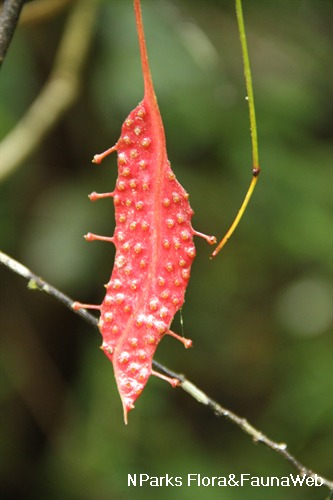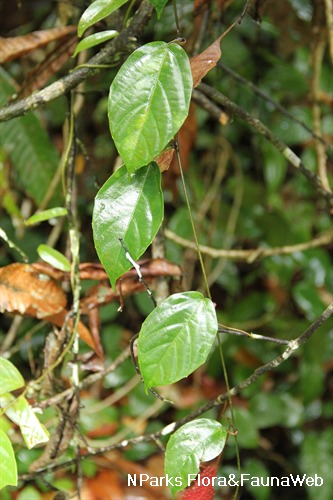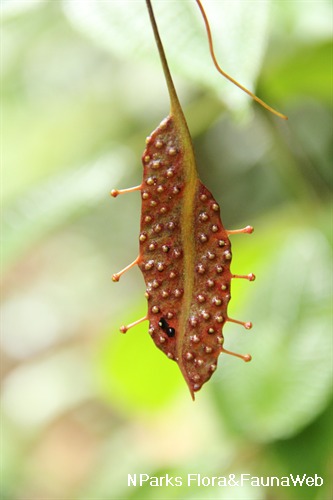
Back
Pterisanthes polita (Miq.) M.A.Lawson
| Family Name: | Vitaceae |
| Synonyms: | Pterisanthes gladiata Steenis, Pterisanthes parvifolia Merr., Pterisanthes sinuosa Merr., Vitis polita Miq. |
| Common Name: | Simple-leaved ribbon vine, Akar janggut baung |
Pterisanthes polita, also known as the Simple-leaved Ribbon Vine, is a critically endangered climber native to Singapore. It thrives in the shaded, moist understorey of lowland dipterocarp and swamp forests. This vine bears distinctive ribbon-like inflorescences. The small, delicate flowers are likely pollinated by bees, while birds are drawn to its small red berries.
Name
Classifications and Characteristics
| Plant Division | Angiosperms (Flowering Seed Plants) (Dicotyledon) |
|---|---|
| Plant Growth Form | Climber |
| Lifespan (in Singapore) | Perennial |
| Mode of Nutrition | Autotrophic |
Biogeography
| Native Distribution | Peninsular Myanmar, Peninsular Thailand, Sumatra, Peninsular Malaysia, Singapore, the Philippines, and Borneo. |
|---|---|
| Native Habitat | Terrestrial |
| Preferred Climate Zone | Tropical |
| Local Conservation Status | Native to Singapore (Critically Endangered (CR)) |
Description and Ethnobotany
| Growth Form | It is a herbaceous climber. |
|---|---|
| Foliage | Its spirally arranged, stalked leaves have papery to leathery leaf blades that are egg-shaped, 7–13 by 4–7 cm, and with toothed margins. They are also covered with hair when young, and hairless or rarely sparsely covered with hair when old. |
| Flowers | Its stalked, red flowering shoot is covered with brown hair and 6.5–27 cm long. They bear few to numerous flowers. |
| Fruit | Its fruits are round berries up to 3–5 mm wide. |
| Habitat | It grows on the fringes and in the understorey of lowland dipterocarp and swamp forests. It occurs locally in Nee Soon Swamp Forest. |
| Associated Fauna | Its flowers are pollinated by bees, and its fruits and seeds may be eaten and dispersed by birds. |
| Cultivation | It can be propagated by seed or stem cuttings. |
| Etymology | Greek pteron, wing; Greek anthe, flower, probably referring to the flat blade-like inflorescence; Latin polita, polished, the reference to which is unknown |
Landscaping Features
| Landscaping | It may be suitable for parks. |
|---|---|
| Desirable Plant Features | Ornamental Flowers |
| Landscape Uses | General, Parks & Gardens, Small Gardens |
Fauna, Pollination and Dispersal
| Fauna Pollination Dispersal Associated Fauna | Bird-Attracting |
|---|---|
| Pollination Method(s) | Biotic (Fauna) |
| Seed or Spore Dispersal | Biotic (Fauna) |
Plant Care and Propagation
| Light Preference | Semi-Shade |
|---|---|
| Water Preference | Moderate Water |
| Plant Growth Rate | Moderate |
| Rootzone Tolerance | Moist Soils, Well-Drained Soils |
| Propagation Method | Seed, Stem Cutting (Herbaceous) |
Foliar
| Foliage Retention | Evergreen |
|---|---|
| Mature Foliage Colour(s) | Green |
| Mature Foliage Texture(s) | Leathery |
| Foliar Type | Simple / Unifoliate |
| Foliar Arrangement Along Stem | Alternate |
| Foliar Attachment to Stem | Petiolate |
| Foliar Shape(s) | Non-Palm Foliage (Elliptical) |
| Foliar Venation | Pinnate / Net |
| Foliar Margin | Serrate / Toothed |
| Foliar Apex - Tip | Acuminate |
| Foliar Base | Cordate |
Floral (Angiosperm)
| Flower Colour(s) | Red |
|---|---|
| Flower Grouping | Cluster / Inflorescence |
| Flower Location | Axillary |
| Inflorescence Size | 6.5 cm x 27 cm |
Fruit, Seed and Spore
| Mature Fruit Texture(s) | Smooth |
|---|---|
| Fruit Classification | Simple Fruit |
| Fruit Type | Fleshy Fruit , Non-Accessory Fruit |
References
| References | Yeo, C. K., W. F. Ang & A. F. S. L. Lok. 2012. Pterisanthes (Vitaceae) of Singapore: With a Note on the Rediscovery of Pterisanthes cissioides Blume. Nature in Singapore. 5. 185-190 |
|---|
Image Repository
Others
| Master ID | 31177 |
|---|---|
| Species ID | 5571 |
| Flora Disclaimer | The information in this website has been compiled from reliable sources, such as reference works on medicinal plants. It is not a substitute for medical advice or treatment and NParks does not purport to provide any medical advice. Readers should always consult his/her physician before using or consuming a plant for medicinal purposes. |





